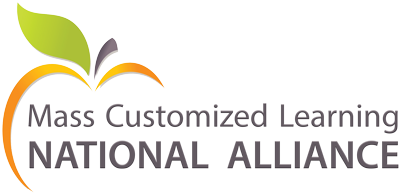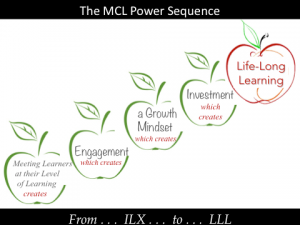Mass Customized Learning for Young Learners (MCL4YL)
MCL . . . from Desire-Ability to Do-Ability
By
Chuck Schwahn, Genny Schwahn, and Jessica Enderson
It’s happening! Mass Customized Learning is happening! Five school districts (better labeled Learning Communities) in three states have successfully implemented mass customized learning for young learners. Learners are excited and very engaged, parents are loving it, learning facilitators are happy, even though it’s hard work getting started, educators by the numbers are visiting to see it happen, and the leaders of the schools (better labeled Learning Centers) are planning expansions for the next school year.
Apple and iTunes has created the ideal listening experience, Amazon the ideal reading experience, Starbucks the ideal coffee experience, and Mass Customized Learning for Young Learners is creating the ideal learning experience. MCL4YL is uncompromisingly learner centered.
The MCL4YL Vision . . .(aka Chapter 11)
The Inevitable: Mass Customized Learning book was basically written as a vision of what education could be and should be. Powerful visions draw people to them and that has been the case with Inevitable. Chapter 7 of Inevitable describes a more specific vision of what a high school could/should be. Chapter 11 describes what a MCL elementary school might look like, feel like, and be like. Chapter 11 gave birth to the challenge and reality of MCL4YL.
If truth were told (we are fessing up), Chapter 11 did not begin with Inevitable. A bit of history here:
- Madeline Hunter (our heroine), UCLA professor and principal of the UCLA Elementary Lab School, and a respected national consultant, was promoting what she labeled “Individualized Instruction.” This was way back when, which is living proof that educators have forever wanted to individualize, personalize, and/or customized learning for learners. We all knew it was right!
- Three teachers from West Elementary in Spearfish, SD listened and learned from Hunter, and over a period of a couple of years, with courageous leadership from their principal, teamed and were able to do what we now call MCL4YL. And, they did it in the 70s before the days of mass customizing technology.
- So when we created the Chapter 11 vision, we sought out the leader of the Spearfish team who had done it, stole/borrowed her memory and model, and added today’s customizing technology. The technology, which of course now makes MCL4YL much easier, more efficient, and more effective, is readily available.
- We knew that it could/would work before we made it the Chapter 11 elementary school vision.
The Pioneers Who Struck Learner Gold and Created the Rush
At the 2016 annual National MCL Summit, in a breakout session, we presented our idea/proposal for making the Chapter 11 vision a reality for learners, learning facilitators, and learning communities. We suggested that we would invite a few schools to work with us for the coming school year to plan to implement MCL4YL the year after. The MCL4YL idea created a good deal of interest and excitement. Many in the group, especially those who were attending as teams, wanted to know more and wanted us to know that they were very interested in being part of the group . . . that they would welcome the opportunity to be MCL4YL pioneers.
Two learning communities (note the new language), Harrisburg, SD and Titusville, PA could not wait through a planning year and were so excited and eager to go that they went home, did some planning over the remainder of the summer, and started the MCL4YL that school year. Some rough bumps in the beginning, but before the school year was completed the program was running rather smoothly . . . AND, they were inundated with visitors who wanted to see and feel MCL4YL in action.
That was the 2015-2016 school year. Moving to the present school year, 2016-2017: Harrisburg, SD had moved from one MCL4YL team to three, and is planning for MCL4YL throughout their elementary schools. Tecumseh, MI is working to implement MCL4YL throughout their system. Brookings, SD, where Jessica Enderson (co-author of this paper) is Principal/Leader, has one team functioning very well with plans for 3 or 4 more teams throughout the Brookings Learning Community next school year. Huntingdon, PA has implemented one team this first year. Titusville, PA has implemented MCL4YL throughout their elementary schools . . . and has had two visits from the PA Department of Education with very positive reviews.
So, MCL4YL is moving from two teams in two states last year, to three states and potentially 10 teams next year. Our take is that you owe it to yourself to visit one of these learning centers to see and feel what it is like. Your will find learner excitement and engagement, learning facilitators who are committed to the vision, and parents who want to tell you how pleased they are with their child’s learning opportunities.
From Industrial Age WBW to Learner Centered Structures
Many/Most educational leaders realize that schools have to change. (Am not so sure that it is “many” or “most,” but I pray that it is “most.”) But our concern is that what many think of as “change,” is not change, but “tinkering.” Hang on for a bit now, this might need some good concentration! If one analyzes today’s schools, it is quite clear that school systems are basically monopolistic, bureaucratic, industrial age, assembly lines, focused on control and administrative convenience. Now that’s a bit harsh and hard to swallow, but it is reality. Our schools have been structured in this manner for so long that we don’t even see or sense the structure when we think about the need for change.
We educators should not feel too down about this as businesses were mostly bureaucratic until about the year 2000 when customizing technology changed the game. Today customers are in charge. They tell business what they want . . . and if they don’t get the product or service that pleases them, they just go elsewhere, and,
tell everyone else about their judgments via social media. So business changed to meet customer needs, but public schools didn’t feel the crunch, as we are basically a monopoly. We don’t feel the same pressure. But today, we educators are feeling the moral pressure to change and transform our systems.
Chapter 8 of Inevitable is titled Weight Bearing Walls (WBWs) and clearly identifies the ten WBWs structure of our industrial age assembly line. Three of those basic structural changes must be made in order to successfully implement MCL4YL:
- We need to stop the assembly line. That is, we need stop assigning and teaching learners based upon their grade level. We need to replace that WBW with a Non-Graded structure that allows for learner grouping and learning opportunities to be based on their learning needs . . . their learning needs right now!
- We need to think “learning facilitator teams,” rather than “teacher, and her/his classroom.” Teaming provides many professional options and numerous advantages for learners.
- We need to embrace Multi-Age classrooms and homerooms. Learners learn in different ways and at different rates. They also learn from more mature learners and learn to be learning facilitators themselves.
These three structural changes are complementary. They fit together and they support each other. Best to do all three to get full MCL4YL benefits.
Discovering How MCL4YL is the start of creating a Lifelong Learner
After watching three teams of MCL4YL in action, and reflecting on the impact this structure was having on learners, we realized a “jewel” that we had not anticipated. Every learning community in the country speaks to their desire to “create lifelong learners.” But few ever act on that desire. Rather, they continue to have courses and graduate students who may or may not have acquired the continuous learning habit of mind.
After observing and communicating with young learners in the Titusville, PA Elementary School, we became believers that MCL encourages and supports a “MCL Power Sequence” that leads to the creation of lifelong learners. The visual below shows a “cause and effect” sequence that is a special bonus for implementing MCL K-12. The visual shows how providing learners with the Ideal Learning Experience leads to the graduation of Lifelong Learners. Start at the lower left.
As we close, we suggest that MCL4YL is a good place to start if your learning community’s vision is to have MCL throughout. The learner mindset has not been set to expect the industrial age assembly line that applies extrinsic motivators. Nothing has to be undone. MCL and intrinsic motivators will be what learners expect throughout their learning experience.
For more information about MCL4YL, see our website at MCL4YL.com.
For more information on MCL structures, see Julie Mathiesen’s paper on this website. Dr. Mathiesen clearly states how MCL, by changing the structure of schools, is more than personalized learning, competence-based learning, mastery learning, etc.


